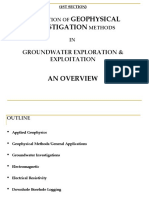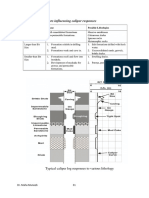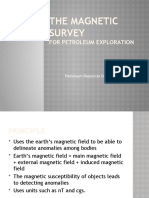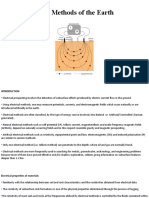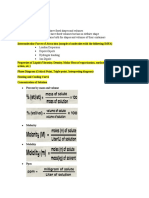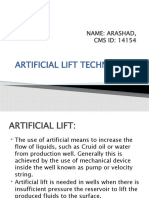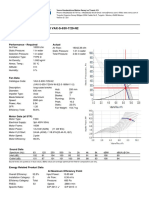Electrical Resistivity Methods 13 PDF
Electrical Resistivity Methods 13 PDF
Uploaded by
Namwangala Rashid NatinduCopyright:
Available Formats
Electrical Resistivity Methods 13 PDF
Electrical Resistivity Methods 13 PDF
Uploaded by
Namwangala Rashid NatinduOriginal Title
Copyright
Available Formats
Share this document
Did you find this document useful?
Is this content inappropriate?
Copyright:
Available Formats
Electrical Resistivity Methods 13 PDF
Electrical Resistivity Methods 13 PDF
Uploaded by
Namwangala Rashid NatinduCopyright:
Available Formats
Electrical
Methods
0Principles &
Applications
0 Graeme Taylor
0 GTaylor@Plymouth.ac.uk
Info On Applied Geophysics
Field Geophysics By John Milsom, Published by John Wiley and Sons, 2003 (or any of the previous
versions)
Reynolds, J. M. 1997. An Introduction to Applied and Environmental Geophysics, John Wiley and Sons
Ltd, Chichester,796 pp. (includes examples from Sourton !)
An Intro. To Geophysical Exploration Kearey, Brooks & Hill Blackwell 2002.
Material that contains explicit info about the Sourton Area
*****BEER, K.E. and FENNING, P.J. 1976. Geophysical anomalies and mineralisation at Sourton Tors,
Okehampton, Devon. Institute of Geological Sciences, Report 76/1.*****
Taylor, G.K., Hake, D.M., King, I.R., & Bowers R. (2001). The Sourton Tors geophysical anomaly revisited.
Geoscience in south-west England, 10, 166-171.
http://www.dartmoor-npa.gov.uk/sheet_1c-b.pdf
Which also contains all the references for the regional geology
http://galitzin.mines.edu/INTROGP/index.jsp
And if you have access to it >>>
Electrical Methods
0Resistivity Methods
0Self Potential SP
0Electromagnetic Methods EM
0Induced Polarisation IP
0Ground Probing Radar GPR
Electrical Methods Applications
0 Depth to bedrock
0 Lithology/lithological boundaries
0 Depth to the water table
0 Groundwater contamination
0 Buried targets e.g.
0 mineralised targets
0 archaeological artifacts
0 UXB and other metallic objects
Resistivity ?
0 What is it ?
0 How can we exploit variations in ground resistivity
to show geology, fluids or other targets?
(Some intro ideas on how current flows in the ground)
0 How do we apply such ideas in the field ?
(Survey types, basic interpretation)
0 Fieldwork, Equipment & Applications/Case
Histories?
Resistance
An analogy
Measuring Resistance- Ohms Law
Ohm found that the
current, I, was
proportional to the
voltage,V, for a broad
class of materials that
we now refer to as
ohmic materials. The
constant of
proportionality is
called the resistance of
the material and has
the units of voltage
(volts) over current
(amperes), or ohms.
Ohms Law
0V = I *R
or
0R= V/ I
BUT will this work in the Earth ?
V - is Voltage in Volts
I is Current in Amperes
R is the resistance in Ohms
It's Resistivity, NOT
Resistance
Resistance depends not only on the
material but also the geometry of
the wire. i.e. length and cross
sectional area
We want to define a property that
describes a material's ability to
transmit electrical current that is
independent of the geometrical
factors. RESISTIVITY
Earth Materials as Conductors
0 Conductors
0 native metals, some sulphide minerals e.g. Chalcopyrite,
Pyrrohotite, Pyrite + graphite
0 Semi Conductors
0 Rock salt
0 Insulators
0 silicate minerals
This means that the vast
majority of rocks will not
be good conductors in
their own right
Poor conductors
Good conductors
Good insulators
Poor insulators
Resistivity Conductivity
How then does electricity flow in
rocks?
0 In metals by the flow of electrons which can be stripped
from the outer atomic shell of a metallic atom
0 this is known as Ohmic or electronic conduction
0 In a liquid this is not possible instead we have
0Ionic or electrolytic conduction - this is the flow of current
by the movement of +ve and -ve ions
Ionic Conduction in Rocks and sediments
0 Pore Space - to contain the Fluid
0 Water saturation - you have to have fluid
or the ions cannot flow
0 Salinity - no Salts = no Ions
0 Temperature - affects a salts ability to
break down into ions and ability to
move
0 Permeability - the pores have to be
connected
Archies Equation?
The Controlling Factors
0 Porosity - depends upon
0 Grain size
0 Sorting/Packing
0 Diagenesis/cementation
0 Normally expressed as a fraction or perecentage
0 Total Void / Total Rock Volume
0 Water Saturation
S
w
= Volume filled with fluid / Total Porosity
0 Salinity
The equivalent concentration of common salt (NaCl) that
would give rise to the same resistivity of fluid as is actually
filling the pore space.
Implications of Electrolytic
Conduction
0 Resistivity is the most variable property of rocks
because
0 it depends upon three important factors which all vary
themselves i.e. Porosity, Sw and Salinity
0 It is not possible to say what the resistivity of the
rock might be even if you know 2 of the 3 e.g. A
sandstone with high porosity and salinity will still
have a very high resistance if it is dry !!!
Summary I
0 Ionic (Electrolytic) conduction is much more common in
rocks than Electronic
0 Electrolytic conduction depends on Porosity, Sw and
salinity
0 We will need to measure the grounds resistivity (not
resistance)
Current Flow in a uniform medium
N.B. Potential = Voltage
The voltage change from a single current electrode to any point in the half
space representing the earth is given by the expression above. In this
expression, V is voltage, I is current, (rho) is resistivity, and r is the
distance between the current electrode and the point the voltage is measured.
Notice that this expression is nothing more than Ohm's law with the
resistance, R equal to over 2r
An expression for the
apparent resistivity
r
I
V
Constant Resistivity Experiment
Current
flow from
2
electrodes
Path % Current
1 17
2 32
3 43
4 49
5 51
6 57
Actually Measuring Resistivity
Potential distribution in a uniform World
The potential computed
along the surface of the
earth is shown in the
graph. The voltage we
would observe with our
voltmeter is the difference
in potential at the two
voltage electrodes, V.
C
C
P
P
+ -
Measuring Resistivity - What
happens if we change the distance
between current electrodes?
What happens if the Earth is not
uniform ? Current Flow in a Layered
Earth
Electrode Spacing and Apparent Resistivity Plots
Variation in Apparent Resistivity: Layered
Versus Homogeneous Media
Current Density
Current Flow in Layered Media v Current Electrode Spacing
A 2
nd
Example
of current
Flow in
layered
media
Summary II
0 The measurements made are V (potential difference
between 2 electrodes) and the applied current
0 50% of the current or more will penetrate no deeper
than the current electrode separation
0 We calculate the measured apparent resistivity using a
modified form of Ohms Law that allows for the
geometry of the electrode array
0 Current will preferentially flow in the low material
0 Current penetrates deeper into the ground with
expansion of the electrode distance
Electrode Arrays
WENNER
SCHLUMBERGER
Asymmetric
Overview of surveys
0 Vertical Electrical Sounding V.E.S.
0 Electrical Sounding, Drilling
0 Constant Separation Traversing
0 Profiling, Trenching
0 Tomography or 2D Surveying
0 which is a combination of both the
above methods
Expanding Arrays for V.E.S. 1
Wenner
C P P C
a a a
a a a
e.g. 0.25, 0.5, 1, 2, 4, 6, 8, 12, 16, 20, 24, 32, 48, 64.. metres
Expanding Arrays for V.E.S. 2
Sclumberger
A B
M N
VES-1
a=1m
a=2m
a=3m
a=4m
a=5m
VES-1
AB/2=1.5, MN/2=0.5
AB/2=2, MN/2=0.5
AB/2=3, MN/2=0.5
AB/2=4, MN/2=0.5
AB/2=5, MN/2=0.5
AB/2=5, MN/2=1
a,m
R
a
1
2
3
4
AB/2
R
a
1.5
2
3
4
a
a,m
AB/2
Wenner Sounding
Schlumberger Sounding
Data Table
Field Curve
Data Table
Field Curve
Multilayered Earth Models I
Relatively
thin middle
layer
Varying
half-space
resistivity
Multilayered Earth Models II
Varying the
thickness of the
second layer
VES Data Plotting
Convention
Plot apparent resistivity as a function of the
log of some measure of electrode
separation.
Wenner a spacing
Schlumberger AB/2
Dipole-Dipole n spacing
Asymptotes:
Short spacings << h1, a=1.
Long spacings >> total thickness of
overlying layers, a=n
To get a=true for intermediate layers, layer
must be thick relative to depth.
Multilayer Curves Summary
0 There is always at least one more layer than there are
turning points on the sounding graph
0 If three layers and 1 > 2 > 3 the it may well appear as if
you only have 1 > 2 Equally the same thing happens for
1 < 2 < 3
0 Also very thin layers or layers with resistivities similar to
those above or below may disappear
Resistivity Profiling/CST
Maps
Profiles
Locate
Boundaries
Constant
Separation
Traversing
Constant Arrays for C.S.T. I
Wenner
C P P C
a a a
C P P C
a a a
C P P C
a a a
1 2 3 4 5 6 n
Wenner array
Profiling: a-spacing is fixed, move the whole array
Constant Arrays for C.S.T. II
Schlumberger
C P P C
1 2 3 4 5 6 n
Single Contacts
0 Some
simplified
responses
to
boundaries
1
>
2
Wenner
Sclumberger
Transverse
Double Dipole
Double Contacts
2
>
1
Wenner
Double Dipole
Sclumberger
Profiling Summary
0 Symmetric arrays give symmetric anomalies
0 Assymmetric arrays give assymetric anomalies
0 A rule of thumb is that the boundary usually lies under the
steepest slope in the anomaly curve
Resistivity
Equipment,
Fieldwork,
and sample applications
Operation for
Constant Separation Traversing
0 Pick electrode spacing (e.g. 10m)
0 Electrodes in ground at 0,10, 20, 30 m (assuming 10m station spacing)
0 Measure point middle of array so 15m
0 Take measurement move on 1 spacing so 10, 20, 30, 40 >>
measurement point 25
0 repeat as needed, if you like you can always infill extra data points at
critical places so 15,25,35,45 would give an extra data point at 30m
along traverse
Operation for
Vertical Electrical Sounding
0 Pick location from other surveys
0 Place two tapes on the ground back to back
0 Electrodes in ground at 0,10, 20, 30 m (assuming 10m station spacing)
4 3 3 2 1 0 1 2 4
Operation for
Vertical Electrical Sounding
0 Spacings
0(0.25), 0.5,1, 2, 3, 4, 6, 8, 12, 16, 24, 32,
64 metres
C1 P1 P2 C2
Try not to get the wires crossed !
!
Start of line GRID REFERENCE End of Line
GRID
REFERENCE
Conditions
Ground surface dry but soil damp should be no problems with
connection
Method
Resistivity CST survey using an electrode separation of 10m in a standard
WENNER configuration
Equipment
used
SAS 300
Terrameter
OPERATOR GKT
Distance -
Midpoint of
Array
Reading
Apparent
resistivity
15 45.4 2852.6
25 37.8 2375.0
35 35.6 2236.8
45 12.6 791.7
55 9.45 593.8
65 9.31 585.0
75 6.54 410.9
85 2.345 147.3
95 2.136 134.2
105 1.965 123.5
115 1.456 91.5
125 1.23 77.3
135 1.115 70.1
145 1.345 84.5
155 1.689 106.1
165 2.43 152.7
175 5.56 349.3
185 12.3 772.8
195 45.6 2865.1
0
5
10
15
20
25
30
35
40
45
50
0 50 100 150 200 250
Reading
Reading
Start of line GRID REFERENCE End of Line
GRID
REFERENCE
Conditions
Ground surface dry but soil damp should be no problems with
connection
Method
Resistivity CST survey using an electrode separation of 10m in a standard
WENNER configuration
Equipment
used
SAS 300
Terrameter
OPERATOR GKT
Distance -
Midpoint of
Array
Reading
Apparent
resistivity
15 45.4 2852.6
25 37.8 2375.0
35 35.6 2236.8
45 12.6 791.7
55 9.45 593.8
65 9.31 585.0
75 6.54 410.9
85 2.345 147.3
95 2.136 134.2
105 1.965 123.5
115 1.456 91.5
125 1.23 77.3
135 1.115 70.1
145 1.345 84.5
155 1.689 106.1
165 2.43 152.7
175 5.56 349.3
185 12.3 772.8
195 45.6 2865.1
10.0
100.0
1000.0
10000.0
0 50 100 150 200 250
L
o
g
A
p
p
.
R
e
s
.
r
h
o
.
m
Distance (m)
Apparent resistivity Line 1
Equipmen
t
Sub-Surface Imaging or
Electrical Tomography
0 A combination of V.E.S. and C.S.T. That provides an image
conveying information both vertical and horizontal
changes in resistivity
0 Needs many readings > must be fast > must be automated
C6.1 Wenner array
C6.1 Wenner array
C6.1 Wenner array
C6.1 Wenner array
C6.1 Wenner array
C6.1 Wenner array
C6.1 Wenner array
C6.1 Wenner array
C6.1 Wenner array
C6.1 Wenner array
C6.1 Wenner array
C6.1 Wenner array
C6.2 Wenner pseudosections of some simple 2-D resistivity models
Forward modelling Example 1
C6.2 Wenner pseudosections of some simple 2-D resistivity models
Forward modelling Example 1
C6.2 Wenner pseudosections of some simple 2-D resistivity models
Forward modelling Example 2
C6.2 Wenner pseudosections of some simple 2-D resistivity models
Forward modelling Example 3
C6.2 Wenner pseudosections of some simple 2-D resistivity models
Forward modelling Example 4
C6.2 Wenner pseudosections of some simple 2-D resistivity models
Inversion Example 1
Figure courtesy of M.H. Loke
C6.2 Wenner pseudosections of some simple 2-D resistivity models
Inversion Example 2
Figure courtesy of M.H. Loke
C6.2 Wenner pseudosections of some simple 2-D resistivity models
Inversion Example 3
Figure courtesy of M.H. Loke
Case Studies - Mineralisation
St. Erth Formation, Cornwall Evidence for an unconformity, evidence of the
clay/brickworks workings >Undisturbed site for future excavation
Engineering Applications
C6.3 Dipole-dipole array
C6.3 Dipole-dipole array
C6.3 Dipole-dipole array
C6.3 Dipole-dipole array
C6.3 Dipole-dipole array
C6.3 Dipole-dipole array
C6.3 Dipole-dipole array
C6.3 Dipole-dipole array
C6.3 Dipole-dipole array
C6.3 Dipole-dipole array
C7.1.1 Cavity detection
C7.1.1 Cavity detection
Figure courtesy of M.H. Loke
C7.1.2 Environmental geophysics
C7.1.2 Environmental geophysics
Figure courtesy of M.H. Loke
C7.1.2 Environmental geophysics
3-D DC resistivity inversion
Figure courtesy of M.H. Loke
C7.1.3 Hydrocarbon exploration
Shallow gas exploration with DC resistivity. Data courtesy of KOMEX
http://iga.igg.cnr.it/geo/geoenergy.php
C7.1.4 Geothermal exploration
Low resistivity
reservoir
Low resistivity
clay cap
C7.1.4 Geothermal exploration
More details http://geothermal.marin.org/GEOpresentation/
Tongonan geothermal field, Leyte Bacman geothermal field, Bicol
Mayon Volcano, Bicol
C7.1.5 Geotechnical exploration
Figure courtesy of M.H. Loke
Time lapse variations
Case Studies V
Summary
0 All fieldwork requires ground contact so relatively slow
0 provides quantitative results in terms of depths/location
0 modern equipment provides for more rapid surveying and
2D and 3D approaches
You might also like
- Irrigation Drainage Review Class 072106Document315 pagesIrrigation Drainage Review Class 072106Fred Nico Paras82% (11)
- Drilling Fluids PresentationDocument81 pagesDrilling Fluids PresentationNamwangala Rashid Natindu100% (1)
- ANSYS CFX-Solver Theory GuideDocument372 pagesANSYS CFX-Solver Theory GuideBhaskar NandiNo ratings yet
- SeisLab For MatlabDocument90 pagesSeisLab For MatlabKattari DwiNo ratings yet
- Depth of InvestigationDocument8 pagesDepth of InvestigationGogot Pantja Parijogo100% (1)
- Richardson EqnDocument3 pagesRichardson Eqnagnirailways100% (1)
- Manual ModeDocument3 pagesManual ModeUdaya Kumar0% (1)
- Zbornik Radova Fakulteta Tehničkih Nauka, Novi SadDocument5 pagesZbornik Radova Fakulteta Tehničkih Nauka, Novi SadИвана КрајновићNo ratings yet
- Geophysical Investigation: Groundwater Exploration & ExploitationDocument77 pagesGeophysical Investigation: Groundwater Exploration & ExploitationBotwe TakyiNo ratings yet
- Engg Geology Lab ManualDocument70 pagesEngg Geology Lab Manualtonydisoja100% (6)
- Geology & Geophysics Matlab Tutorial PDFDocument16 pagesGeology & Geophysics Matlab Tutorial PDFquangNo ratings yet
- Handouts For Seismic MethodsDocument32 pagesHandouts For Seismic MethodsAnna KissNo ratings yet
- Field Report GeophysicsDocument28 pagesField Report GeophysicsObioma SmartNo ratings yet
- Caliper LogDocument9 pagesCaliper LogMd Al-AminNo ratings yet
- September 10, 2018 Lab 1: One-Dimensional Analysis of DC Resistivity DataDocument10 pagesSeptember 10, 2018 Lab 1: One-Dimensional Analysis of DC Resistivity DataNur Rochman MuhNo ratings yet
- GeophysicsDocument64 pagesGeophysicsrizkaNo ratings yet
- Seismic MethodDocument90 pagesSeismic MethodMorhaf KhouleNo ratings yet
- Geophyiscs - NotesDocument13 pagesGeophyiscs - NotesHugo DuchovnyNo ratings yet
- Static ReviewDocument20 pagesStatic Reviewcristianc2ga92No ratings yet
- Seismic Data Processing and InterpretationDocument15 pagesSeismic Data Processing and InterpretationmustafaNo ratings yet
- Induced Polarization (IP) MethodDocument25 pagesInduced Polarization (IP) MethodAdexa PutraNo ratings yet
- Epge - Seismic Interpretation - Loops 2022-2023Document36 pagesEpge - Seismic Interpretation - Loops 2022-2023guilhermecalado11No ratings yet
- Imaging Passive Seismic DataDocument11 pagesImaging Passive Seismic DataJaenudin ZenNo ratings yet
- Depth Analysis of Parts of Sokoto Basin, Northwestern Nigeria Using Spectral Analysis and Euler Deconvolution MethodsDocument15 pagesDepth Analysis of Parts of Sokoto Basin, Northwestern Nigeria Using Spectral Analysis and Euler Deconvolution MethodsMomoh KabiruNo ratings yet
- Induced Polarization (IP) : Basic PrinciplesDocument30 pagesInduced Polarization (IP) : Basic PrinciplesAlejandro Chvez AlatorreNo ratings yet
- 2D Resistivity Method To Investigate An Archaeological Structure in Jeniang, KedahDocument8 pages2D Resistivity Method To Investigate An Archaeological Structure in Jeniang, KedahHidaya MztzNo ratings yet
- Seismic Petrophysics PDFDocument28 pagesSeismic Petrophysics PDFmunaf afridiNo ratings yet
- GPRDocument5 pagesGPRrolandNo ratings yet
- Magnetic MethodDocument91 pagesMagnetic MethodFisseha KebedeNo ratings yet
- Introduction To Geophysics: ERTH2020Document51 pagesIntroduction To Geophysics: ERTH2020Isna NurainiNo ratings yet
- 2010 04 RECORDER Model Based Seismic InversionDocument12 pages2010 04 RECORDER Model Based Seismic Inversiondanjohhn0% (1)
- Seismic AcquisitionDocument223 pagesSeismic AcquisitionRalmerAlanaPutra100% (1)
- Evaluasi Prospek MIGASDocument27 pagesEvaluasi Prospek MIGASsaiqadhaNo ratings yet
- Seismic Interpretation Report GuidelinesDocument3 pagesSeismic Interpretation Report Guidelinesn_shekar100% (2)
- 3D Geoelectrical Problems With ResiPy An Open Source Graphical User InterfaceDocument9 pages3D Geoelectrical Problems With ResiPy An Open Source Graphical User InterfaceSantiago chacon camargoNo ratings yet
- Affecting Data ProcessingDocument26 pagesAffecting Data ProcessingekkyNo ratings yet
- MATLAB NoteDocument15 pagesMATLAB Notemsalam2No ratings yet
- Seismic 101 LectureDocument67 pagesSeismic 101 Lecturerobin2806100% (2)
- 2-D SURVEY DESIGN - FinalDocument47 pages2-D SURVEY DESIGN - Finalasmita100% (1)
- Designing 3D Seismic Surveys: Stacking BinsDocument7 pagesDesigning 3D Seismic Surveys: Stacking BinsmythygpbhuNo ratings yet
- Petrel 2015 Whats New Ps PDFDocument4 pagesPetrel 2015 Whats New Ps PDFTroy ModiNo ratings yet
- Petrel 2013Document4 pagesPetrel 2013Milloshy RamirezNo ratings yet
- The Magnetic SurveyDocument15 pagesThe Magnetic Surveymelannie adanteNo ratings yet
- Oasi Montaj GMSYS 3DDocument4 pagesOasi Montaj GMSYS 3DBerhanu bekeleNo ratings yet
- Structural TasterDocument12 pagesStructural TasterAdri Muhammad RassalNo ratings yet
- GPR Data Process PDFDocument18 pagesGPR Data Process PDFInkjiwo RahaNo ratings yet
- LAB BOOK (Seismic Imaging and Modelling) Paul Ssali 17390138 Submitted PDFDocument328 pagesLAB BOOK (Seismic Imaging and Modelling) Paul Ssali 17390138 Submitted PDFJill DagreatNo ratings yet
- Unit-III: Geophysical Methods of Mineral ExplorationDocument40 pagesUnit-III: Geophysical Methods of Mineral ExplorationMunther DhahirNo ratings yet
- ElectrDocument89 pagesElectrgeoscientistoneNo ratings yet
- Seismic ReflectionDocument26 pagesSeismic ReflectionJeevan BabuNo ratings yet
- 7.5 GPR Vs SeismicReflectionDocument16 pages7.5 GPR Vs SeismicReflectionAdi SusantoNo ratings yet
- Tutorial: 2-D and 3-D Electrical Imaging Surveys: Email: Mhloke@pc - Jaring.myDocument134 pagesTutorial: 2-D and 3-D Electrical Imaging Surveys: Email: Mhloke@pc - Jaring.myAnonymous zABjgCQNo ratings yet
- B0088ZW6FG EbokDocument59 pagesB0088ZW6FG EbokLeonardo Octavio Olarte Sánchez100% (5)
- P190Document25 pagesP190John PattersonNo ratings yet
- Geophysical Methods For Petroleum ExplorationDocument30 pagesGeophysical Methods For Petroleum ExplorationGunalan RNo ratings yet
- (Lecture 9) Geoelectrical MethodesDocument14 pages(Lecture 9) Geoelectrical MethodesJasonNo ratings yet
- Volve Seismic ST10010 Report - 1545785889Document108 pagesVolve Seismic ST10010 Report - 1545785889kamNo ratings yet
- Lecture 8 Magnetic MethodDocument30 pagesLecture 8 Magnetic MethodSiyad AbdulrahmanNo ratings yet
- Chapter 3 Geophysical StudiesDocument42 pagesChapter 3 Geophysical Studiesbalaji xeroxNo ratings yet
- Geophysical Methods: Presentation/LectureDocument53 pagesGeophysical Methods: Presentation/LectureAdam Sukma PutraNo ratings yet
- VISTA Tape ManualDocument56 pagesVISTA Tape ManualBelghali BibaNo ratings yet
- Fault InterpretationDocument242 pagesFault InterpretationHuỳnh TuấnNo ratings yet
- Basin Analysis: Principles and Application to Petroleum Play AssessmentFrom EverandBasin Analysis: Principles and Application to Petroleum Play AssessmentRating: 4.5 out of 5 stars4.5/5 (3)
- Atlas of Structural Geological Interpretation from Seismic ImagesFrom EverandAtlas of Structural Geological Interpretation from Seismic ImagesAchyuta Ayan MisraNo ratings yet
- Rivers and Floodplains: Forms, Processes, and Sedimentary RecordFrom EverandRivers and Floodplains: Forms, Processes, and Sedimentary RecordNo ratings yet
- Electrical Resistivity Methods 13Document108 pagesElectrical Resistivity Methods 13Anthony WrightNo ratings yet
- ZKTecoDoor Access Controller-UpdatedDocument1 pageZKTecoDoor Access Controller-UpdatedNamwangala Rashid NatinduNo ratings yet
- Access ControllerDocument1 pageAccess ControllerNamwangala Rashid NatinduNo ratings yet
- KeikaDocument1 pageKeikaNamwangala Rashid NatinduNo ratings yet
- Annual Plan Sida Ict Library Sub-ProgrammesDocument24 pagesAnnual Plan Sida Ict Library Sub-ProgrammesNamwangala Rashid NatinduNo ratings yet
- Brand Model Specification Estimated PriceDocument2 pagesBrand Model Specification Estimated PriceNamwangala Rashid NatinduNo ratings yet
- Proposed Ict Facilities - Coecvs at Mloganzila1.04.2019Document20 pagesProposed Ict Facilities - Coecvs at Mloganzila1.04.2019Namwangala Rashid NatinduNo ratings yet
- Boq Vs OrderedDocument1 pageBoq Vs OrderedNamwangala Rashid NatinduNo ratings yet
- BasicPetro 2 PDFDocument157 pagesBasicPetro 2 PDFNamwangala Rashid NatinduNo ratings yet
- 2012-13 Ruvuma Basin Annual Hydrological ReportDocument28 pages2012-13 Ruvuma Basin Annual Hydrological ReportNamwangala Rashid NatinduNo ratings yet
- Desk Infromation AreaDocument2 pagesDesk Infromation AreaNamwangala Rashid NatinduNo ratings yet
- 3 (C) Explain Tools For CriticalDocument5 pages3 (C) Explain Tools For CriticalNamwangala Rashid NatinduNo ratings yet
- 6 141023133550 Conversion Gate02Document48 pages6 141023133550 Conversion Gate02Namwangala Rashid NatinduNo ratings yet
- Well Planning: Habiburrohman AbdullahDocument30 pagesWell Planning: Habiburrohman AbdullahNamwangala Rashid NatinduNo ratings yet
- Cementing: Habiburrohman, B.Eng, M.EngDocument52 pagesCementing: Habiburrohman, B.Eng, M.EngNamwangala Rashid NatinduNo ratings yet
- What Makes Up A PC?Document10 pagesWhat Makes Up A PC?Namwangala Rashid NatinduNo ratings yet
- Session 7Document23 pagesSession 7Namwangala Rashid NatinduNo ratings yet
- Session 2Document17 pagesSession 2Namwangala Rashid NatinduNo ratings yet
- What Makes Up A PC?Document9 pagesWhat Makes Up A PC?Namwangala Rashid NatinduNo ratings yet
- Session 3Document13 pagesSession 3Namwangala Rashid NatinduNo ratings yet
- What Makes Up A PC?Document12 pagesWhat Makes Up A PC?Namwangala Rashid NatinduNo ratings yet
- Session 4Document23 pagesSession 4Namwangala Rashid NatinduNo ratings yet
- Session 1Document6 pagesSession 1Namwangala Rashid NatinduNo ratings yet
- Reinforced Concrete Design-I (Lab Part) : The University of LahoreDocument69 pagesReinforced Concrete Design-I (Lab Part) : The University of LahoreShaheryar AhmadNo ratings yet
- Q3 Pointers To ReviewDocument10 pagesQ3 Pointers To ReviewRonel CahayagNo ratings yet
- Artificial Lift TechnologyDocument24 pagesArtificial Lift TechnologyAkoery AkoeryNo ratings yet
- INSTRUCTOR MANUAL ThermoconductivityDocument4 pagesINSTRUCTOR MANUAL ThermoconductivityFajobi AbeebNo ratings yet
- 1st Prelim in Science 8Document1 page1st Prelim in Science 8Neniel DumanjogNo ratings yet
- Exer 6Document10 pagesExer 6Jayca JacaNo ratings yet
- Sem 3 Bt8302 Atb Question BankDocument54 pagesSem 3 Bt8302 Atb Question BankPJ ABISHEKNo ratings yet
- Determination of Rock Strength and Deformability oDocument13 pagesDetermination of Rock Strength and Deformability oAna RaquelNo ratings yet
- Chemistry, 7-8-6Document25 pagesChemistry, 7-8-6Kissha TayagNo ratings yet
- Height Datum & Height Determination Using GNSS in SingaporeDocument59 pagesHeight Datum & Height Determination Using GNSS in SingaporeMarco ConopioNo ratings yet
- Statistical Mechanics - Is Avogadro's Law Applicable For Atoms or Just For Molecules - Physics Stack ExchangeDocument7 pagesStatistical Mechanics - Is Avogadro's Law Applicable For Atoms or Just For Molecules - Physics Stack ExchangenavyanonaNo ratings yet
- Structural Design Criteria 1.0 Codes and StandardsDocument4 pagesStructural Design Criteria 1.0 Codes and StandardsChrispin BarnigoNo ratings yet
- Grade 8 Lesson Exemplar Consolidated-1Document58 pagesGrade 8 Lesson Exemplar Consolidated-1Hilcris Gideon EslabraNo ratings yet
- Bernoulli's Theorem PDFDocument6 pagesBernoulli's Theorem PDFKaushik KunteNo ratings yet
- Lecture 3 - Wheatstone BridgesDocument33 pagesLecture 3 - Wheatstone BridgesnoniNo ratings yet
- Drude Model-WikipediaDocument6 pagesDrude Model-WikipediaGabriel0% (1)
- Technical Data For Fan Model VAX-S-630-7/29-N2: Performance - Required ActualDocument2 pagesTechnical Data For Fan Model VAX-S-630-7/29-N2: Performance - Required Actualkarim tarekNo ratings yet
- Physics 5Document16 pagesPhysics 5Jo Ces100% (1)
- NPSH ReportDocument6 pagesNPSH ReportJhun Ray EsquilloNo ratings yet
- Combustion Engineering Borman PDFDocument2 pagesCombustion Engineering Borman PDFChase0% (4)
- CHEMISTRY INVESTIGATORY PROJECT Class 12Document17 pagesCHEMISTRY INVESTIGATORY PROJECT Class 12Cinin . SNo ratings yet
- Lourve: Product InformationDocument8 pagesLourve: Product Informationntt_121987No ratings yet
- Torsional Vibration RotorDocument59 pagesTorsional Vibration Rotordaongocha108100% (1)
- Quiz 1Document2 pagesQuiz 1abhi srivastavaNo ratings yet
- Determination-Of-Freezing-Point-DepressionDocument8 pagesDetermination-Of-Freezing-Point-DepressionAllan TampusNo ratings yet








